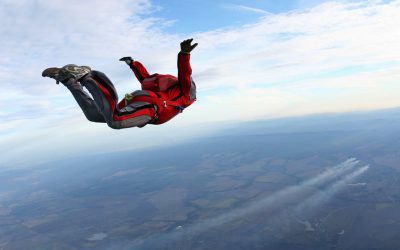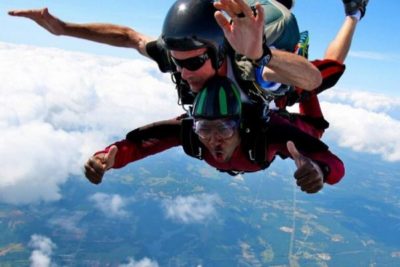Four-minute freefalls and talking in freefall … these are both MYTHS that have been created by Hollywood. While we love the movie Point Break, the skydiving scene with Patrick Swayze and Keanu Reeves gives a false depiction when they not only freefall for three times the normal amount – but also have a full-blown conversation while in freefall!
So – can you talk while skydiving? NO. Well … you can talk, but nobody is going to hear you! Let’s explain why that is totally impossible and go over other ways that skydivers communicate!
How Loud is Skydiving?
Skydiving is a decibel-rich activity in general. From the moment you step foot on the dropzone, you’ll hear the hustle and bustle inside the hangar while you’re waiting to jump, followed by the airplane ride and freefall. We can measure noise level using decibels to determine exactly how loud skydiving is, but you will find the loudest part of your skydiving experience is during freefall. Let’s break it down now, y’all!
Just for a point of reference, it is said that a normal conversation is around 60 dBA. We can use this measurement to compare exactly how loud you can expect things to be on the day of your skydive.
- Plane Ride:
Noise levels on skydiving aircraft can vary depending on engine type, cabin soundproofing, and wherever you are sitting in the aircraft. Skydiving airplanes are not like most commercial aircraft and usually are not pressurized. Whether you’re in a King Air, Caravan, or a Cessna 182, the decibels can range anywhere from 62 to 86 dBA inside the plane. So, it is loud but not quite loud enough to damage your hearing.
- Freefall:
The measurement of noise levels in freefall will vary depending on body position and how fast you’re flying and can be difficult to measure. In general, it is safe to say that the noise level for a skydiver in freefall is around 115 dBA. It’s said that you would need to be exposed to this level of noise for 2 to 5 minutes before having any kind of damage to your ears. Luckily, the freefall portion lasts about 45 to 60 seconds.
The noise levels do have the potential to decrease with earplugs or for skydivers who are able to wear helmets, but that exact number is unknown!
- Canopy Ride:
After having the rush of your life during freefall, the instructor will deploy the parachute and your experience will switch. The canopy ride is comparatively silent and tranquil. As you float back down to Earth, you’ll be surprised at how relaxing it feels to be isolated from all the noise and monotony of everyday life. It’s an experience like no other, like a giant hug from Mother Nature!
How Do Skydivers Communicate?
Since skydivers can’t hear each other while in freefall, they find other ways to communicate non-verbally. You can try to use eye contact or read lips as much as you want, but nothing is quite as effective as communicating with hand signals.
 Here are some of the most common hand signals that you might see (these hand signals are usually used for students who are learning to skydive solo).
Here are some of the most common hand signals that you might see (these hand signals are usually used for students who are learning to skydive solo).
- Arch:
Normally displayed as a thumbs-down, this signal reminds you to keep a curved or arched body position by pushing your hips forward.
- Extend Legs:
“Chuck up the deuces!” If someone gives you a sideways peace sign while in freefall, that means to straighten, or extend, your legs. This can help you stabilize or move forward in freefall.
- Check Arms:
Now, give a thumbs-up and then stick your pinky out. This “shaka” sign is usually known for hang loose or relax, but in the skydiving world it means check arms. Some people lose complete awareness of where their arms are or what position they’re in so the check arms signal is a reminder to get those arms in the correct position.
- Wave Off:
This signal is solely for experienced skydivers. In order to wave off, you’ll take both of your arms and cross them in an X shape, return to neutral, and repeat once more. This is the signal that you are about to open your parachute. It is a warning to other skydivers to clear their airspace.
Come see all there is to see and hear all there is to hear with Skydive Monroe. Book your skydive today! Blue Skies.
Copyright © 2025, Skydive Monroe, All Rights Reserved.
DropZone Web Design & Marketing by Beyond Marketing, LLC




